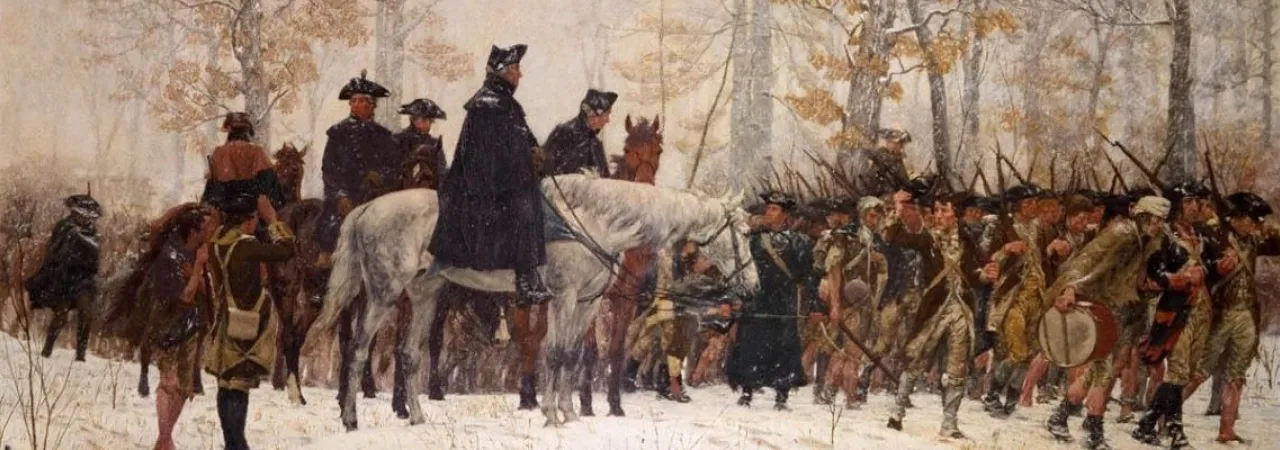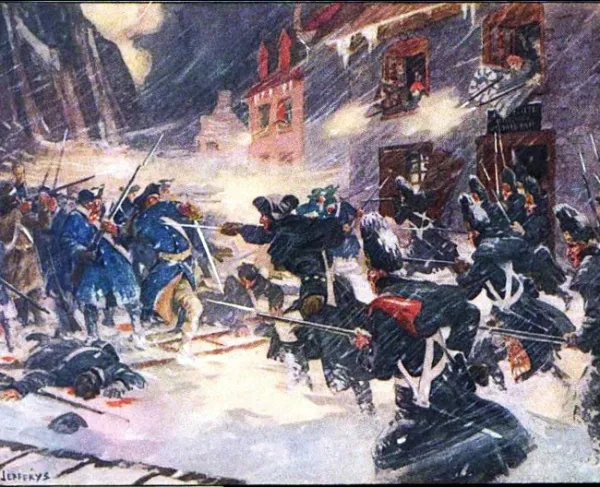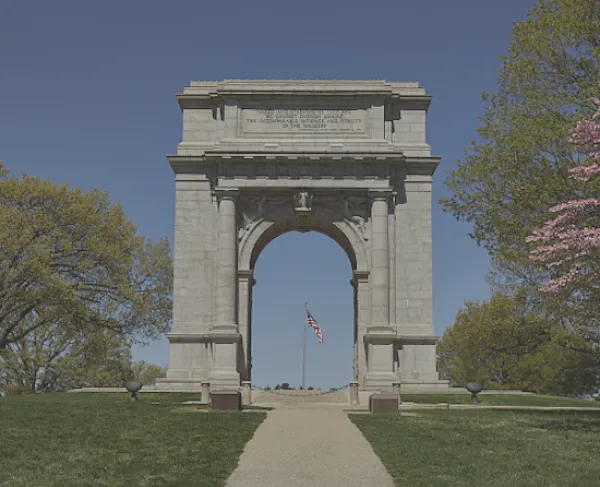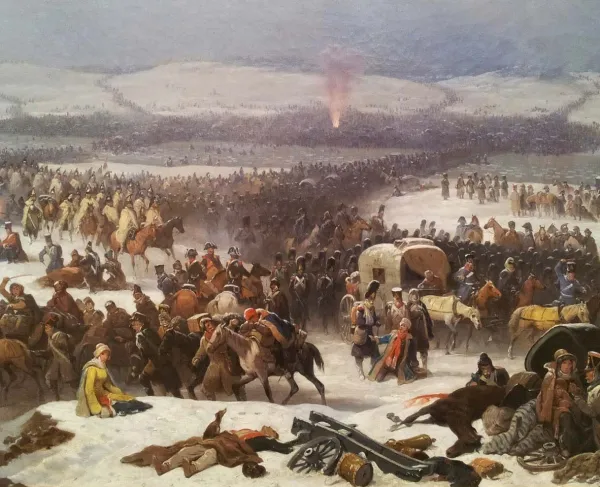
On December 2, 1777, General George Washington wrote to Joseph Reed about the issue of where to encamp the Continental Army for the upcoming winter of 1777-1778. He had called multiple councils of war and even ordered his general officers to submit their opinions and choices in writing. A clear consensus was not reached, either by the officer’s picks or by Washington himself, “so many and such capital objections to each mode proposed, that I am exceedingly embarrassed, not only by the advice given me, but my own judgment.”
Washington and his army, at the time of that missive to Reed, were encamped in the hilly terrain north of Germantown, Pennsylvania, in an area called White Marsh. On December 5, General William Howe’s British forces instigated a series of maneuvers that led to skirmishing along the front. Washington would not take the bait and emerge from his defensive works. Within the next few days culminating on December 7, Howe realized the uselessness of continuing operations and marched his forces back to Philadelphia. Active campaigning season in 1777 culminated with that retrograde movement.
Washington, who had begun considering where to place the army for winter quarters as early as late October, began moving the forces out of White Marsh days after the engagements in the area ended. He had discounted White Marsh as a possible winter cantonment due to the lack of wood available for the construction of huts, the dearth of supplies in the immediate area, especially to the east toward Philadelphia, which was heavily foraged, and lastly on the possibility that any movement by Howe or British forces would precipitate a need to respond and put the army on alert. A move to the west, interspersing the Continental army between Philadelphia and York, where the Continental Congress had set up operation, and Reading, where the Pennsylvania legislature had settled seemed prudent. Being close to Philadelphia was also a necessity, to keep a lookout for the British and try to pen them in as close to the environs of the city as possible was a military necessity. Ideas suggested by subordinate officers, after a council of war was called, produced a wide array of options that tentatively fit these requirements, from places in an arc around Philadelphia to Wilmington, Delaware.
All these considerations weighed on Washington’s mind. That plethora of options presented by the general officers invited to those councils of war also bore consideration. Due to the necessity of secrecy at the time, Washington’s complete rationale for picking Valley Forge is not known. The area, though, checked most of the proverbial boxes as a place to winter the army.
Starting on December 8, elements of the Continental army left White Marsh and crossed to the western side of the Schuylkill River. Much of the army decamped on December 11, while the sick and any wounded were transported to Reading. By December 13, Washington’s forces were encamped at the Gulph and four days later, Washington received word from General Anthony Wayne, a native Pennsylvanian of the suitability of Valley Forge, located approximately ten miles from where the army was currently situated. Although he loathed to split up the army under his command, Washington bent to necessity and dispatched troops from Delaware and Maryland to winter quarters in Wilmington, Delaware to protect the countryside and supplies in that area.
Valley Forge was a suitable option for a multitude of reasons. The proximity to Philadelphia, 18 miles to the southeast of Valley Forge allowed for Washington to monitor British activity and ascertain any intentions of a strike on his army with time to prepare. The densely wooded terrain provided ample firewood for the construction of winter quarters and initially to keep fires blazing for food and warmth. Nearby, the Schuylkill River flowed, providing a source of water for camp use. The waterway also provided some protection in conjunction with the hilly terrain providing means of defense in case of a British strike.
The army spent the night of December 18 at Gulph Mills, then marched up the road toward a prominence ironically named Mount Joy, five miles from the previous night’s encampment. Mount Joy was one of two prominent hills that provided protection for the ensuing winter encampment, the other was named Mount Misery. Both names are applicable to what the Continental Army would face during the six months at Valley Forge.
As the soldiers continued the march, a 5,000-acre plot of land unfolded in front of their vision. The area was known to locals as Valley Forge. Due to the geographic outlay of the land and the forge in operation gave the name Valley Forge. European inhabitation stretched back to the turn of the eighteenth century in the surrounding area.
The approach of the Continental Army was not the first instance of the war coming to Valley Forge. On September 18, 1777, British soldiers arrived in the area and in the ensuing two days torched the forge and accompanying buildings while confiscating any supplies that could be transported. Out of consideration of the locals, the gristmill was left undisturbed in September.
Washington’s army would spread out even more within the Valley Forge area eventually covering approximately 7,800 acres of land. Higher ranking officers fanned out to look for their winter accommodations in permanent structures that dotted the landscape. Washington’s staff selected the Isaac Potts house as his headquarters for the winter. The stone house took over two years to construct and was finished in 1770. By December 1777 the house was occupied by Mrs. Deborah Hewes, a relative of the Potts. Due to Continental law, which forbade mandatory accommodations, Washington’s staff arranged a price with Mrs. Hewes on rent.
The native Virginian hunkered down within Valley Forge to suffer, in a degree, with the wintry weather and privations faced by the rank-and-file. The encampment began on the night of December 19, the men sleeping either under the late autumn moon or under canvas tent flaps. The next morning, construction began on the more permanent winter abodes.
Orders dictated by Washington’s headquarters instructed the soldiery on the art of hutting. The huts should measure 14 by 16 feet, include a fireplace, and be lined with 18 inches of clay for insulation. Wood planking was ordered to be used for the roofs, however, a dearth of sawmills in the local area made this more a pipedream than reality. To provide an incentive, Washington authorized a $100 reward to any person under his command that could provide a suitable alternative. Eventually, the landscape was transfigured, from open pasture and woodland to a series of wooden cities numbering approximately 2,000 huts and laid out by brigades in a giant semi-circle around Valley Forge.
The ability to make the huts taxed the ingenuity and skills of the soldiery. As one soldier recorded, “We are now about to build Hutts for shelter this winter Expect in a few days to be comfortable, tho we have nothing convenion to work with – Axes are very scarce –[…]we have but one dull ax to build a Logg Hutt When it will be done knows not.”
The 2,000 approximate huts housed between 12,000 to 14,000 soldiers during the six months of the winter encampment at Valley Forge. Although there were limited tools to construct their winter living quarters, there was pride in that within the first month much of the soldiery were housed in their huts. Within the wooden walls between 8 to 12 men slept in bunks. Junior officers enjoyed a bit better lodging.
Behind the huts for the non-commissioned officers and privates, the placement and occupation of the next set of huts were as follows from Washington’s General Orders of December 18. One hut to every “General Officer, one to the Staff of each brigade, one to the field officers of each regiment, one to the commissioned officers of two companies."
As the men finished their living spaces for the next six months, the winter encampment of Valley Forge truly began along with the suffering that would mark their time at Valley Forge. Approximately 2,000 soldiers succumbed to illness and other maladies during the winter. Another 3,000, a quarter of the men who marched into Valley Forge in December, were lacking the essentials of clothing in some manner.
However, those six months saw a transformation of the army. In spring the introduction of a training regimen under the tutelage of Baron Frederich von Steuben was implemented. In March 1778, Nathanael Greene accepted the position of quartermaster general and energetically strove to correct the many irregularities and issues facing that department. Washington handled political intrigue about his army command, weathered the storm, and came out a stronger leader, cementing a bond of his leadership over the army. With his constant presence around camp during that winter, he created a common bond of enduring suffering together.
Although the direct thinking of George Washington on selecting Valley Forge as the winter encampment will never be completely known, the camp did serve its purposes. From protecting both the Continental Congress and Pennsylvania state legislature to being a defensive locale for his own troops, and having access to woods to supply material for winter huts. Valley Forge was the best of the options presented to Washington in the late fall of 1777 and he made the decision accordingly.
Six months to the exact day that the Continental army marched into Valley Forge, the soldiery began the movement out. On June 19, 1778, approximately 15,000 men, larger than the number agreed upon by historians that marched into Valley Forge, broke camp. Headed toward the summer campaigning season which started with the Battle of Monmouth nine days later. Valley Forge, the selection for a winter encampment by George Washington after much consternation and uncertainty, now belonged to history.






